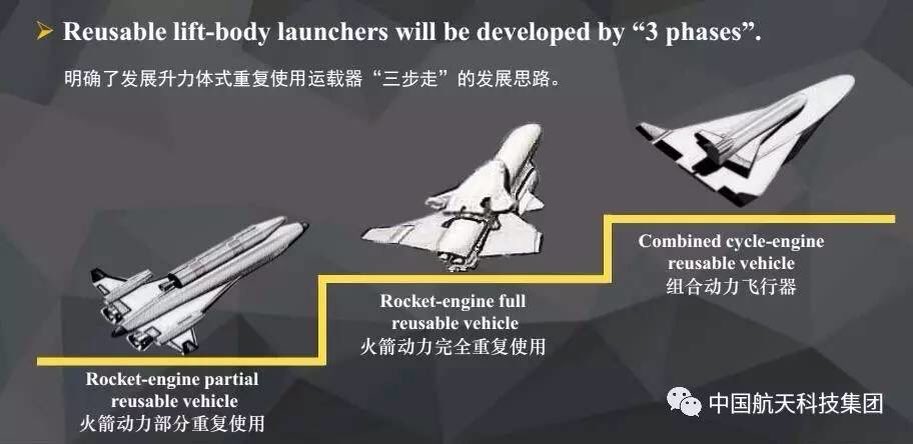East Pendulum has a story about a ten year CASIC project to develop a two stage space plane with the first stage having combined turbo jet / scram jet propulsion:
No promise that will be deployed, just a very deep look into the possibilities if I understand the article correctly.
It is just study here is the translation
CASIC, one of China's two national aerospace groups, appears to have taken a major step forward in the development of its spacecraft called "
Teng Yun " (腾云). In any case, it was officially announced
at the international conference
Global Space Exploration 2017 (GLEX 2017), which is held from 6 to 8 June in Beijing.
According to LIU Shi Quan (刘石泉), the reusable spacecraft - with take-off and horizontal return - achieved "significant" progress and the project has already completed ground testing for several of its key technologies, Including the propulsion system.
The model of the Tengyun spacecraft presented at the GLEX 2017 conference (Images: CCTV-13)
One can also have another view of this space plane "Teng Yun" from 00:30 of this video -
The "Teng Yun" spacecraft is part of one of the five strategic projects launched by CASIC in 2016 in the field of commercial aerospace. The Chinese giant, with nearly 150,000 employees in the country, has decided to invest more than 100 billion yuan (more than 13 billion euros) over 10 years in these 5 projects as well as a new family of launchers With solid propellant.
A new aerospace design and construction base will be built in Wuhan City as part of these projects, which also include solar drones, aerostats, Wi-Fi mini-satellites and the network of connected objects, as well as Fast launchers and rockets with electromagnetic launch.
As for the "Teng Yun" project, its objective is to build and fly by 2030 a RLV (Reusable Launch Vehicle) consisting of two "stages" - an orbiter device similar to a mini space shuttle, and a carrier itself, Even recoverable.
The latter, equipped with a Turbine Based Combined Cycle (TBCC) combined propulsion system, which consists of coupling a turbojet reactor for the horizontal takeoff phase and first acceleration, and a ramjet or scramjet to achieve speed and speed The necessary altitude about 30 to 40 km from the ground, will release the orbiter which will continue its course with its own rocket engines.
Once the "parcel" is delivered, the carrier will return to the ground by posing as a normal plane. CASIC aims at the objective of a lifetime of 100 cycles for the orbiter and the wearer.
The headgear of the Kuaizhou rockets of the CASIC group
The elements made public today indicate that the project has just completed, at the end of 2016, its phase of technical demonstration which allows to choose the architecture and the final configuration of the future space plane.
The tests referred to by LIU should therefore be of this nature, in particular at the level of the TBCC engine, and not elaborate products.
The project is then planned to carry out a series of ground simulation on the TBCC engine before conducting flight tests by 2020.
CASIC intends to complete the development of the main components by 2025, and to carry out the first experimental flight in 2030.
It should be noted that "Teng Yun" is not the first and only spacecraft currently under development in China, and it is unlikely that the one chosen by the Chinese State as the spacecraft second generation.
Indeed, the CALT Institute (China Academy of Launch Vehicle Technology), builder of the Longue Marche rockets and subsidiary of another large Chinese aerospace group CASC ( without I ), also built a small experimental shuttle Called "
Ao Tian 1 ", which, in the strict sense of the word, can be classified in the RLV category rather than a space plane (nor for Teng Yun because the orbiter can not take off horizontally).
Another mini-shuttle project, known as "
Shenlong " (Dragon Divine), designed this time by the 611 Chengdu Institute - a subsidiary of the Chinese aviation group AVIC and designer of fighter jets and drones like
J-10 ,
J-20 or
Wing Loong and
EA-03 - has also conducted several dropping tests in recent years. The project was codenamed 863-706 under the 863 Program.
We have very briefly mentioned these two projects in our dossier "
" last year.
The old technical proposals on the future Chinese RLV
Shenlong (top right) and Ao Tian 1 (bottom right)
If our information is accurate, it would be the 611 Chengdu Institute, although an actor in the aeronautics sector, who finally won the contract financed by the Chinese government for the development of the future spacecraft (or at least one RLV).
The objective is to enable the country to have a low-cost, reusable space access tool capable of being relaunched in less than 48 hours after the previous return to Earth and ready for take-off with a maximum of 8 hours preparation.
And the new code name of this state project, 921-706, is very revealing, because the figure 921 actually corresponds to Program 921, that is to say the Chinese manned flight program which was launched in 1992.
It may be pointed out that at the time, between 1987 and 1992, before the 921 Program was officially launched, six technical proposals were studied and compared in the framework of Project 863-204.
If one of them, proposed by the CASC Institute of the CASC group, became the Chinese
Shenzhou man-made ship that we know today, there was actually another candidate who looks like the "Teng Yun" project of CASIC of today, even if the latter would probably be a "private" project.
The different spatial transport configurations studied in project 863-204, between 1987 and 1992.
To be continued.



